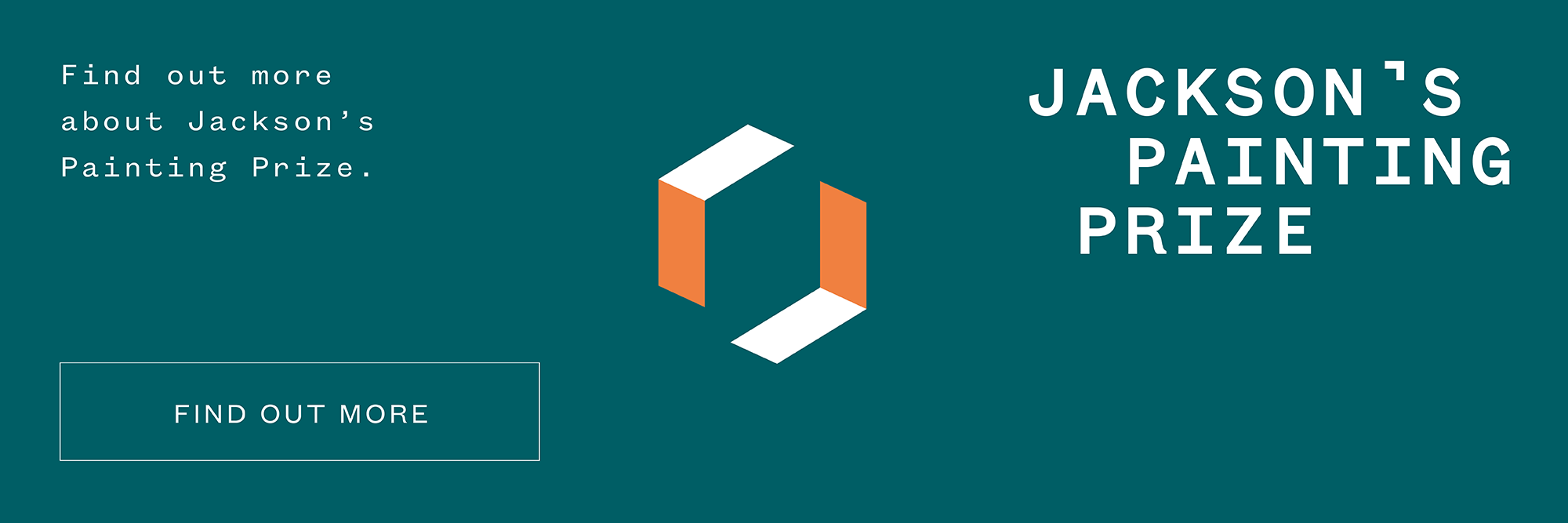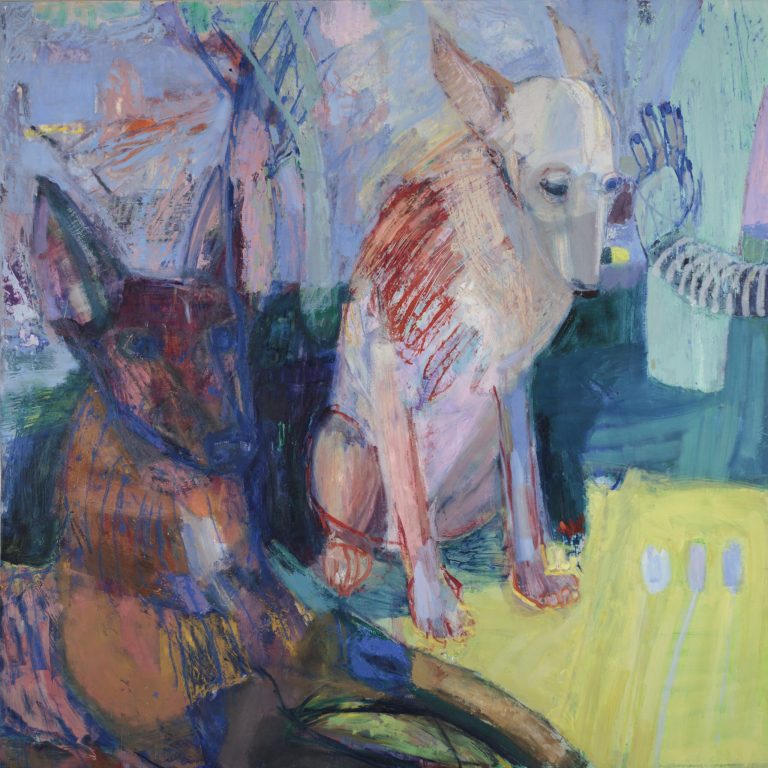Julie Karpodini won the Animal Award in the Jackson’s Painting Prize this year with her work Elvira’s Dogs. In this interview, Julie discusses her well developed processes, sketchbook practice, and communication with her paintings.
Above image: Julie working in her studio in rural Spain.
Lisa: What is your process for starting a painting, and is it always the same approach?
Julie: I usually begin with very fast sketches, generally in oil. I have sketchbooks lying around with pages primed in a particular clear acrylic primer I like, so that if the sketch becomes more than a sketch the work is somewhat archival. When I am working on a commission the start tends to be a lot clearer, as I have limitations to work within and am often provided with photos from the client. I use the photos for a visual spark or idea that I like and then make sketches from that. After the initial start I use the sketches as my source material and put the photo or photos away. If distance allows, I like to take the photos myself which gives me a kind of head start. When I am not working on a commission I might have a person in mind that I want to paint, or a kind of generalised idea, (right now a lot of that revolves around double portraits, and the energy that exists between two figures). I will get as many ideas down as quickly as I can in these oil sketches. I am looking for a general composition that I find interesting, but many of my ideas also come to me through colour. If I have a good moment in my day of painting, there is an ease and a sense of rightness. I see a colour harmony or particular disharmony that I like. This might happen in reaction to the subject, but as often as not it is an idea from another painting or an older sketch. Once I have something that I want to push further I try and feel out the scale and then begin something on stretched canvas or prepared paper. Once a mark is made it just becomes an interaction with the piece, and a web of problem solving. It never really ends up very close to the idea of the original sketch, but I need that beginning.
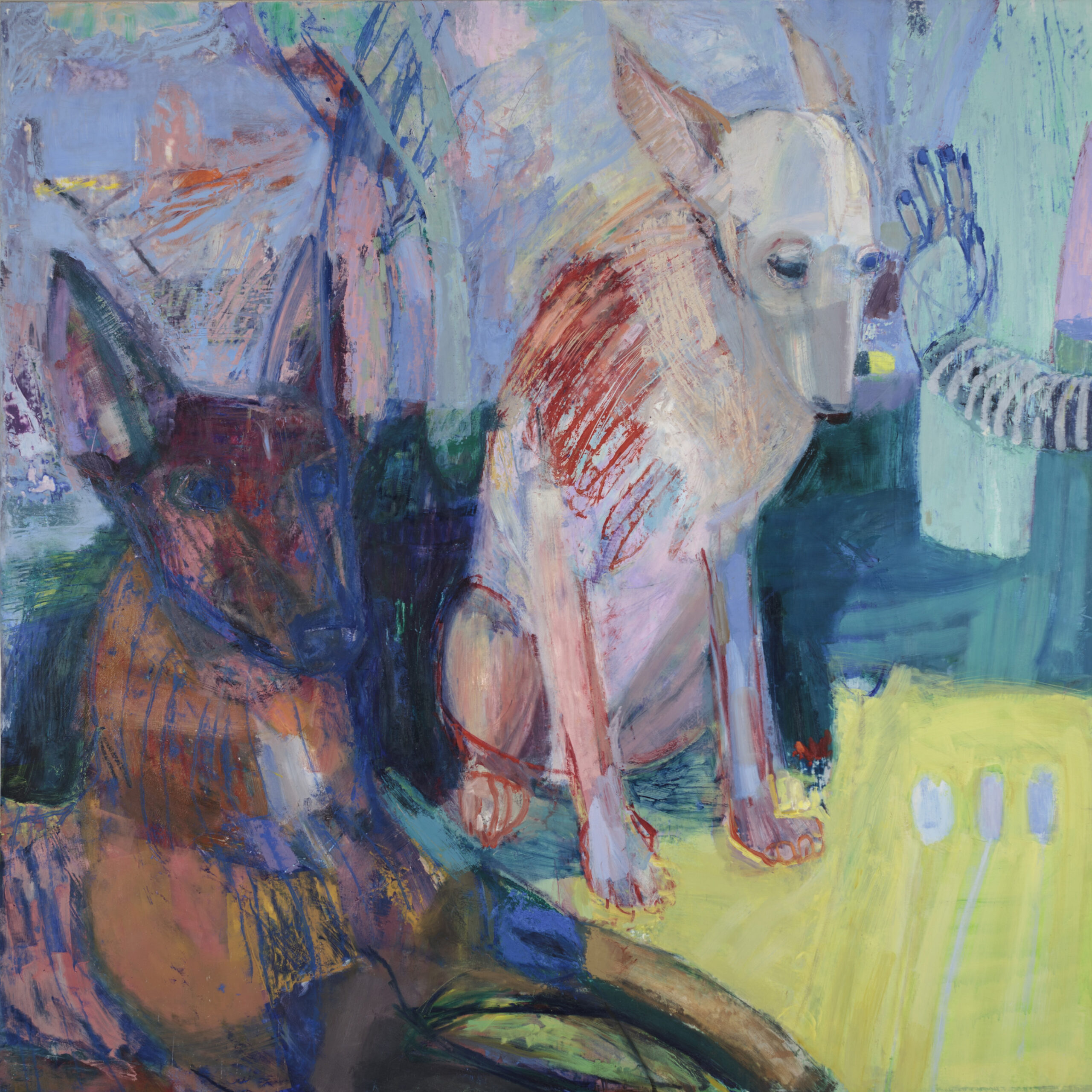
Elvira’s Dogs, 2021
Julie Karpodini
Oil on canvas, 150 x 150 cm | 59 x 59 in
Lisa: How important is drawing for you, do you keep a sketchbook?
Julie: I keep many sketchbooks, and drawing is very important to me, but not in the classical sense. I got my MFA from New York Studio School, which is an atelier-based school with a huge emphasis on drawing from life. It was an incredible experience, and I feel very lucky to have had it as it involved drawing from a live figure or from a still life daily, with a lot of focus on going deeply into the drawing process, and also a lot of discussion of formal issues. I was lucky enough to have had truly amazing teachers, and it was an education in the depth that drawing and painting can have. However, as amazing as it was, it also took a long time for me to let go of that language in my head and find my way back into my own process. I think it’s really important to study, but equally important to forget it all! Right now, I draw before I begin a painting, from my imagination or from photos, but I also draw continually throughout the painting process. Drawings of the painting, little paintings of the painting, working out the issues. My sketchbooks are interesting for me to look back on because they contain the evolution of each painting. I can see the stages it went through and the problems I was working out. It is often in these sketches that the ideas for another painting come from. When I can I still work from life, but it’s more as a practice of its own as opposed to something that feeds into what I make in my studio. Up until Covid we had a drawing group in the village I live in where we would have models come once a week. It’s a really good muscle to work.
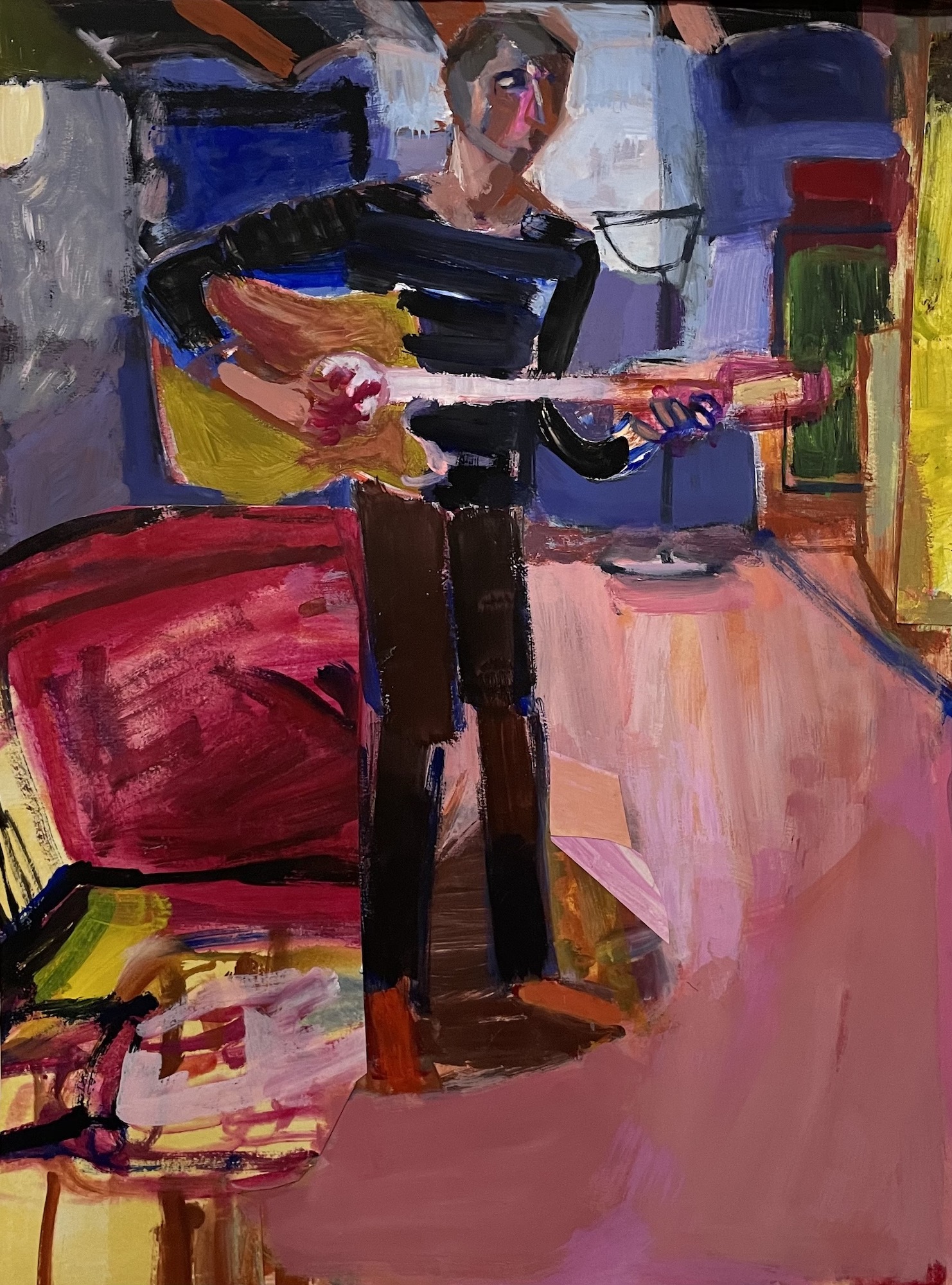
Scott Playing Guitar in the Living Room, 2022
Julie Karpodini
Flashe Vinyl on paper 47 x 64.5 cm | 18.50 x 25.39 in
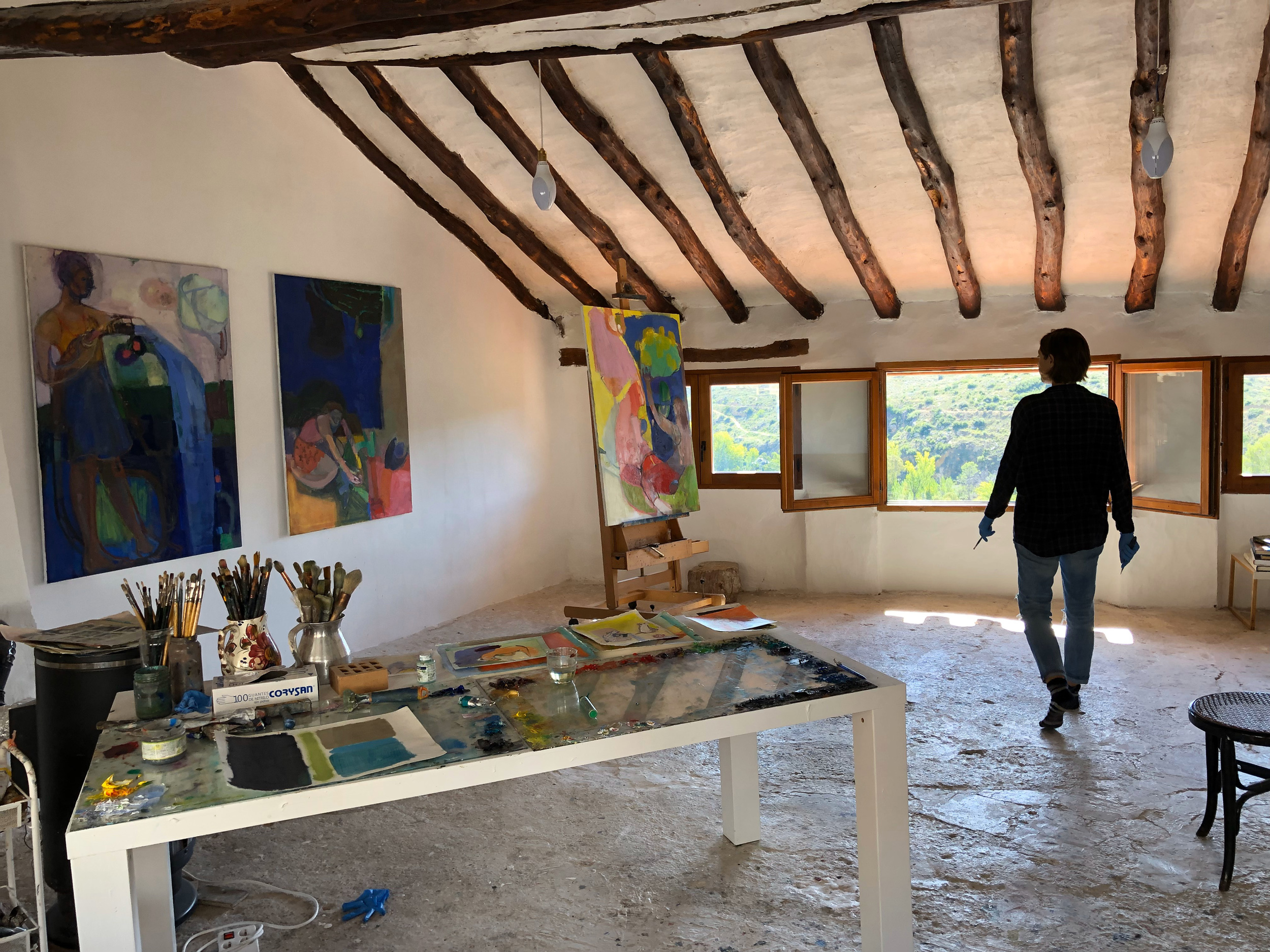
Julie Karpodini in her studio in Chelva, Spain 2019
Lisa: You’ve mentioned that paintings will change drastically on the canvas as they are painted. What determines these changes?
Julie: The changes, big and small, are determined by other changes. It’s very much cause and reaction, and a search for a composition, colour and feeling that feels right. It’s the whole process of painting in a way. The beginning is often almost perfect to me, and from there it just becomes a communication with the painting, and a way to try and get back to that perfect point. Every painter is looking for that moment where ‘it works’, where for whatever reason everything holds together. The hope (for me) is that the painting is not killed on the path to that moment. I have always had a personal issue with going too far, and it’s not always in the paintings best interest. These days I try to make smaller, more concise changes, but that is easier said than done! I am still always moving the composition and the colours until it feels right. The movement of painting, the dance of it, is kind of a balance between the subconscious and the conscious mind. When you are making changes from only an analytical place it’s awful (for me). The best times are when the changes are almost instinctual and are clear. One thing happens and then the next, and I don’t really need to think too hard, it just presents itself. Those moments are rare though, and in-between them I am looking, looking, drawing, and then shifting. When it works best the painting is in charge and I am in a clear enough place to trust what happens. At its worst I miss that point, continue changing and then have to work backwards somehow. Sometimes you get that ‘good five minutes’ and everything just is clear and I have had times where a painting is finished as fast as it started. Everything just worked out. Getting out of your own way is important. There is a Philip Guston quote I heard recently that I love; ‘When you are in the studio painting there are a lot of people in there with you – your teachers, friends, painters from history, critics… and one by one if you are really painting, they walk out. And if you are really painting YOU walk out’.
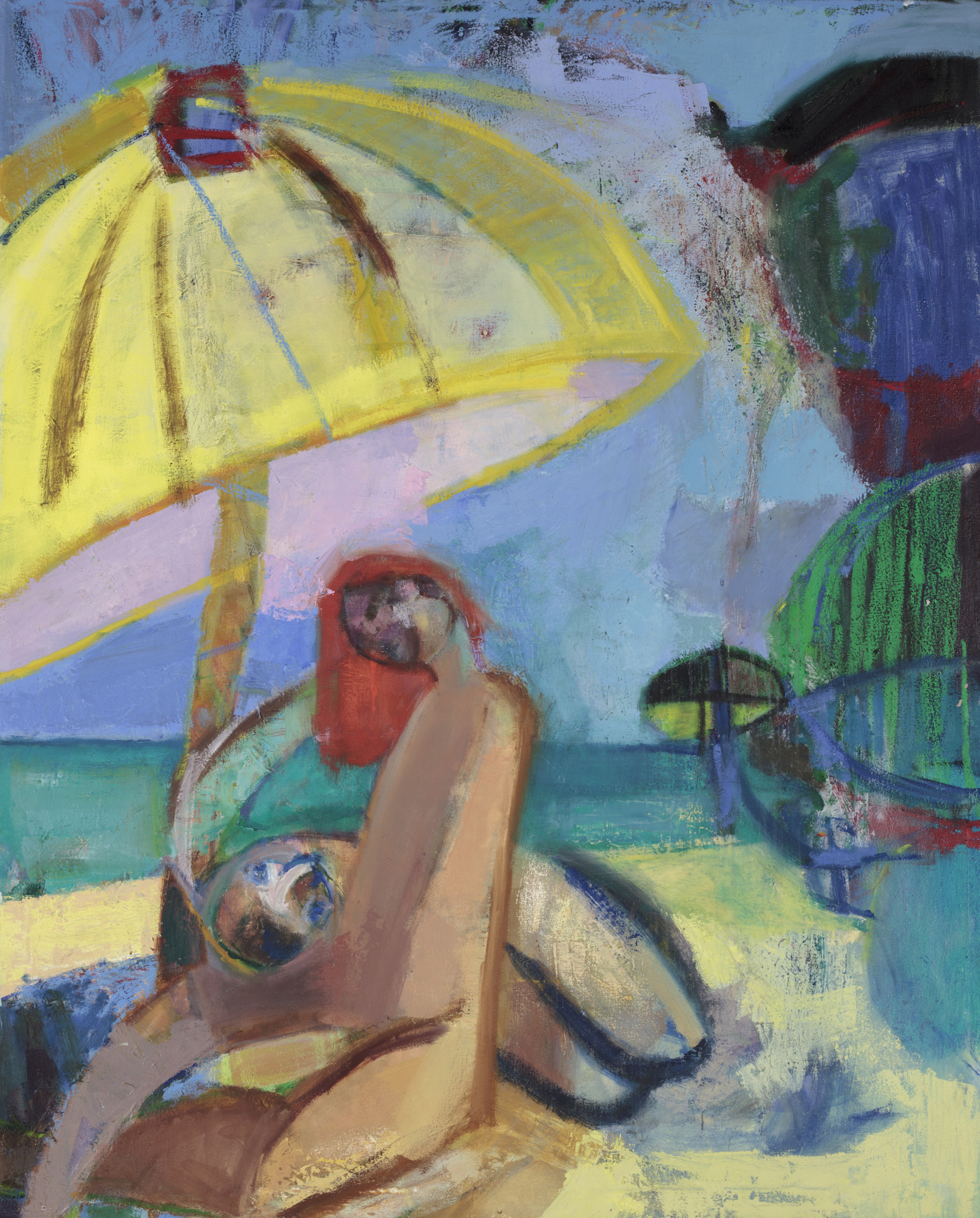
Paros, 2021
Julie Karpodini
Oil on canvas, 120 x 90 cm | 47.24 x 35.43 in
Lisa: What is your favoured surface on which to paint, and which paints do you like to work with?
Julie: I like a very smooth canvas, so lately I prime with an acrylic based primer, then wet sand and repeat at least three times. The result is a very smooth surface on which paint can be pushed easily. I have also started stretching the canvas flat on a large panel board, which allows me to change the composition and scale as I go (up to a point), so that the final dimensions are not decided on from the get go. I am also working on paper a lot these days. I just got a roll of Arches Hot Pressed Watercolour Paper which I will prime with a clear acrylic primer. I am really enjoying working on paper because it gives me a lot of freedom with the composition. I can add and subtract to get the scale right and I am also collaging on top. It’s given me a fresh start. Up until recently I only painted in oil paints. I love Williamsburg Oil Paints (when I first moved to New York I found a bunch of half used Williamsburg Oil Paints next to a garbage dump in a small wooden box, and since that introduction I have always loved working with them whenever I can afford to!). I had a baby two years ago and during the pregnancy I tried using water-based oil paints, which was fun, and recently I discovered Flashe Vinyl, which is totally a different world for me, and has been very invigorating. I love the matt quality of it, and it challenges me think in a new way, so it’s been a good change. I also like that I can oil paint on top of it.
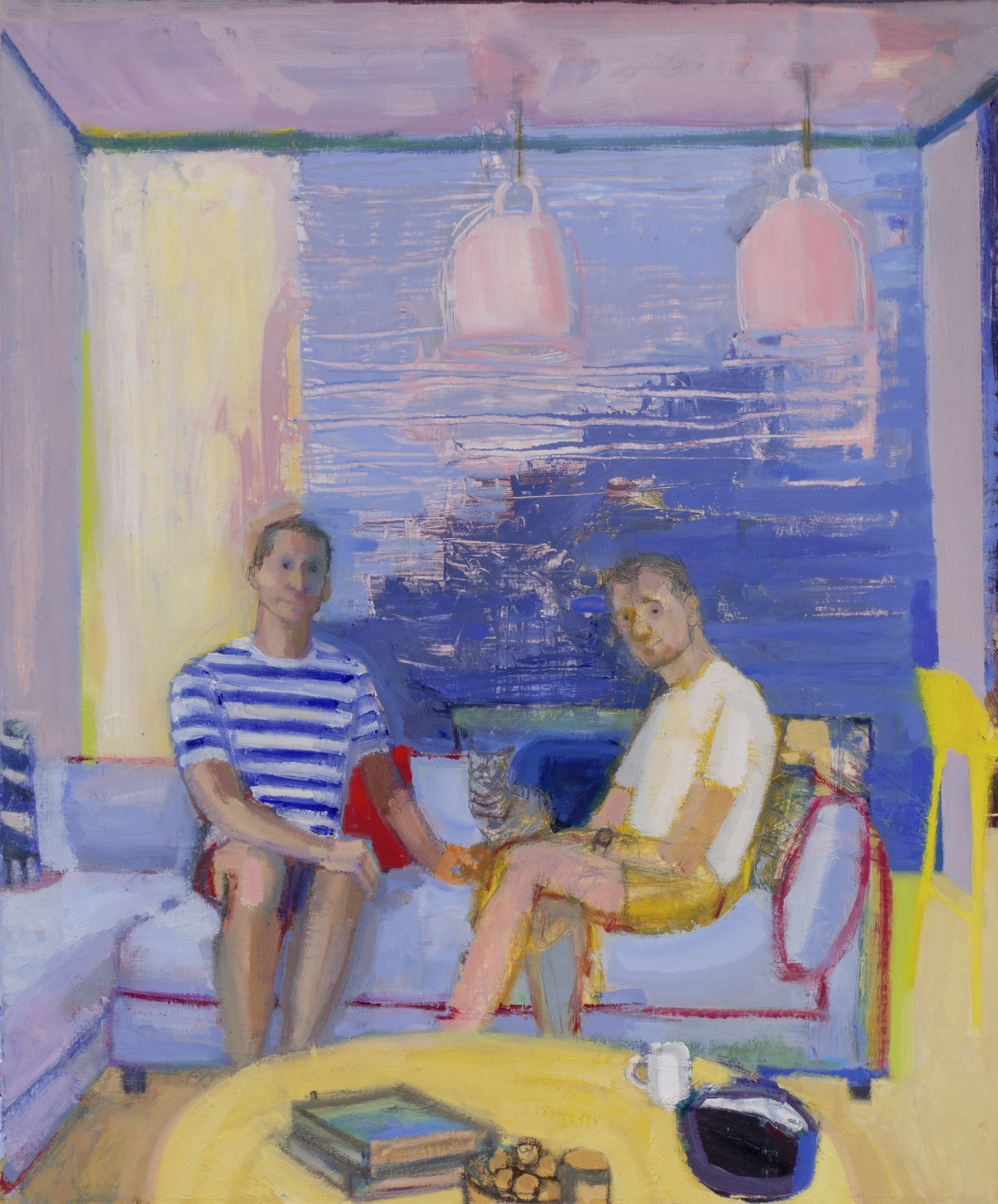
Neil and Eric, 2020
Julie Karpodini
Oil on paper, 50 x 41 cm, 19.68 x 16.14 in
Lisa: You have travelled around the world as an adult, studying both in the UK and in New York, and now living in the mountains in rural Spain. How have changes in your environment impacted upon your painting practice?
Julie: The main way I think my work is affected is through my studio space. I was very nomadic up until fairly recently and that is not really helpful for having a congruent studio practice. I am not someone that has an easy time making work on the go, since I often work for a long time on single pieces. New York was amazing, (as was the UK) but affording studio space was hard, and I kept having to move to more affordable locations, further out of the city. In the end it was very exhausting for me. I came to Spain, to this village on a residency, and met my partner here. We bought a large old home seven years ago, mainly because of the amazing studio spaces in it! He is a musician, so it’s important for both of us to have this space to create. I think my work is really developing now, probably for the first time! It’s been a long slow journey for me, and I am getting closer to where I want to be. Another huge change in this environment is that it allows for affordable child care. If I lived in NY, I don’t think we would be able to survive financially and also have a child in daycare. As a female artist with a child, having affordable daycare within walking distance (and a partner that shares child care with me) has meant that my studio practice has continued relatively uninterrupted. Living here allows me to be in my studio daily, and to have a good quality of life. So, the changes are not really in subject matter or colours (although I am sure that subconsciously happens), but more in the change to a sustainable life as an artist.
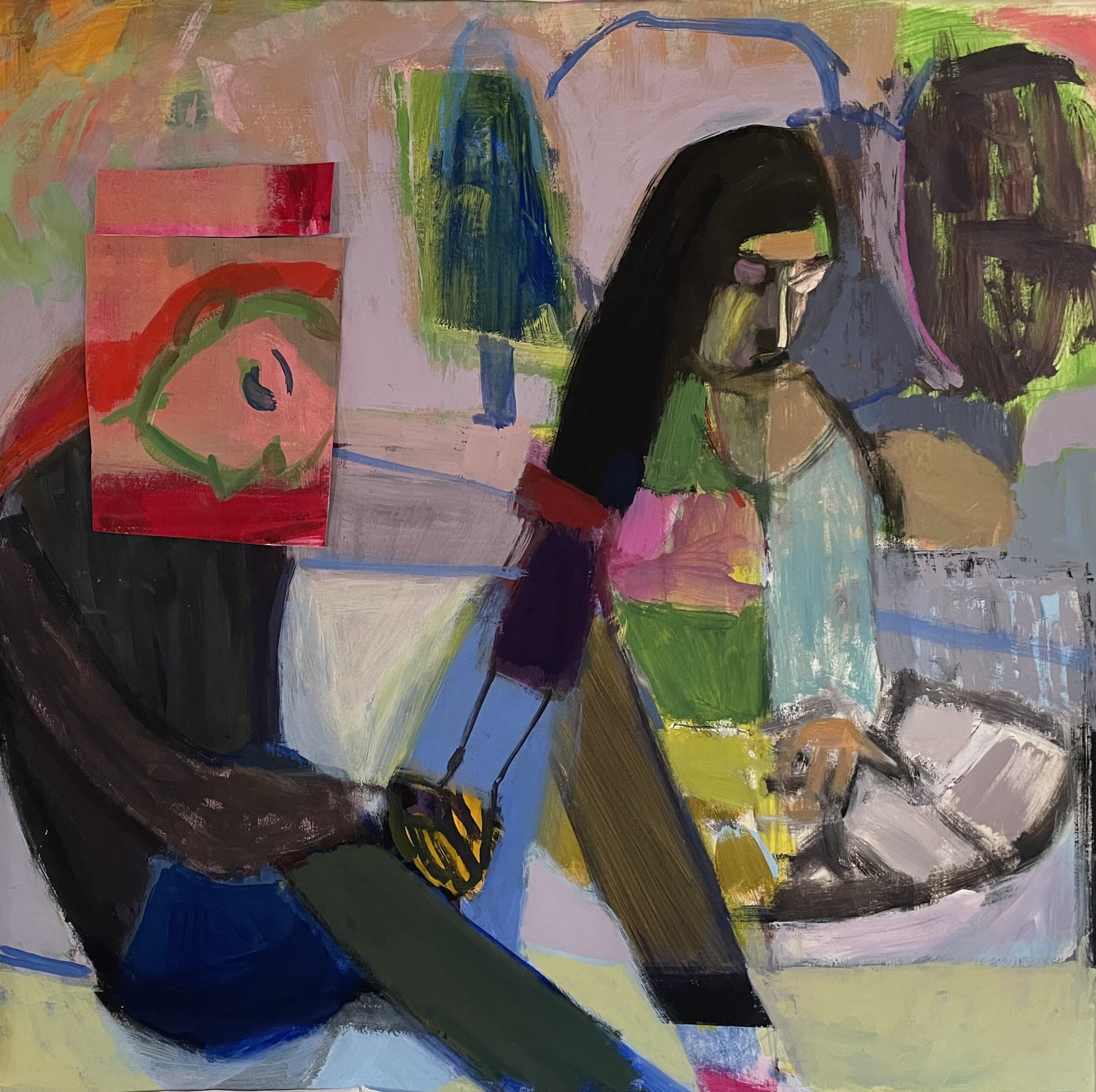
Jenny and Rachel
Julie Karpodini
Flashe Vinyl on paper, 62 x 63 cm | 24.40 x 24.60 in
Lisa: Your paintings have beautiful colour harmonies within them. Can you tell us how you select your palette, and is this determined before you load your brush and start putting paint to canvas?
Julie: Thank you! I guess this relates to the earlier question regarding starting a painting. I am very much a colourist, as it really leads my work. For a long time, I was working with a very broad range palette, but right now I try to start with a colour idea, often from a sketch, and I only put out the colours on my palette that relate. As I continue, I add what I need. So yes, it is determined before I load my brush, but as with everything it’s always changing. Right now, I am working on a large piece with beautiful warm reds. The colour harmony is from a sketch that really worked, and of course in the painting it’s totally different, so I have had to completely change my original idea and find what could work in the new piece, with completely different colours, but still remaining aware of the vitality I liked in the sketch. There are a lot of lucky mistakes, a lot of trial and error and also a lot of instinctual decisions made.
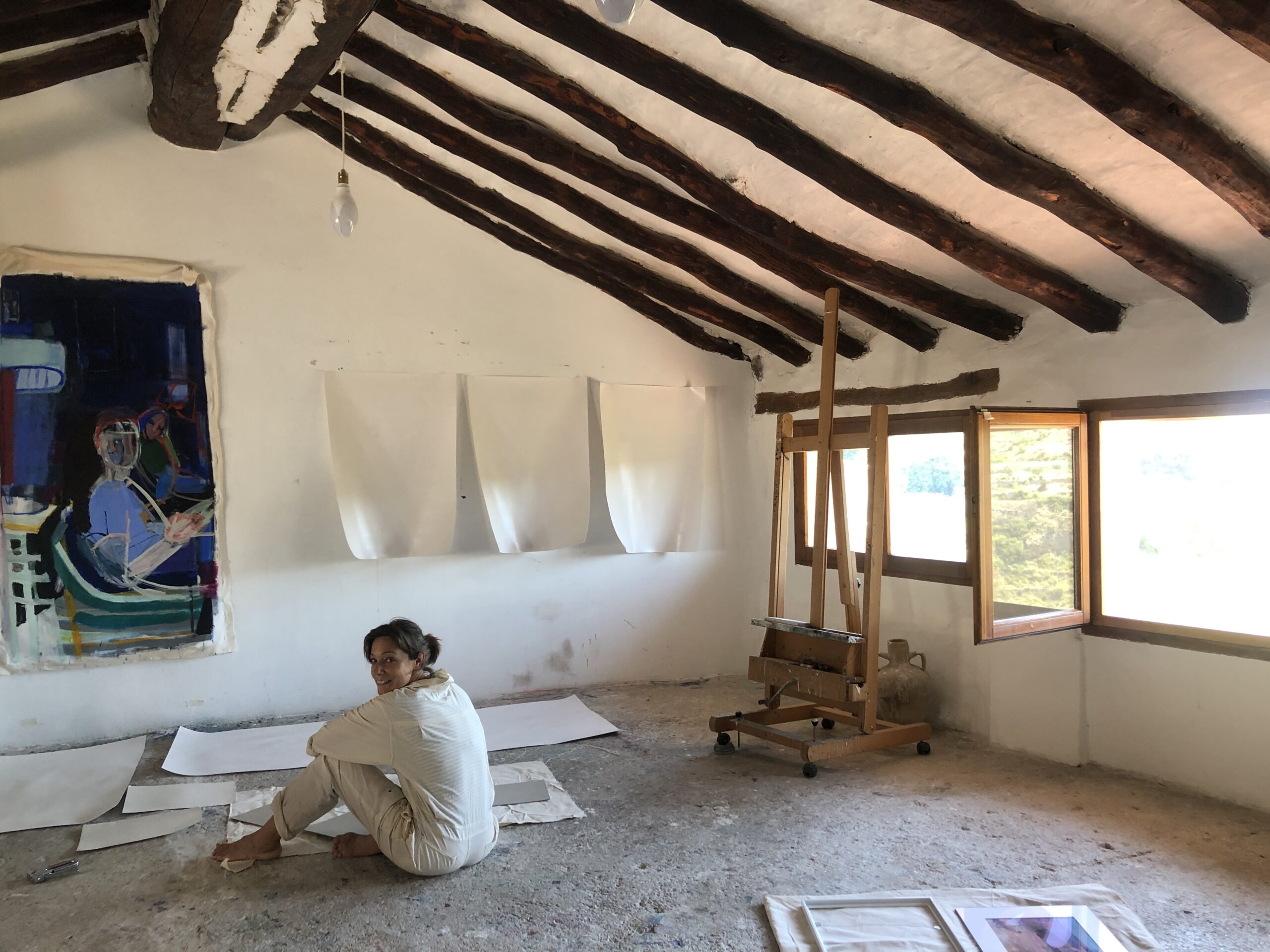
Julie Karpodini in her studio in Chelva, Spain 2022
Lisa: Please could you describe your ideal setting for a painting session?
Julie: An ideal setting? I guess that would be a full day in my studio without anything to draw my attention away. We have a toddler, studio practices and other jobs on the side. We are still renovating our home (it is about 200 years old so I think the renovations may be never ending) and we are also trying to set up a small artist’s retreat – so there are a lot of things going on in life. I am in my studio every day, for a set amount of time, so I really have to be conscientious with the work. I have to not be distracted by emails that need to be written and electricians that need to be called etc. There is a lot I want to do, but there really is not time for all of it, so the ideal setting is just one where I can close the door on everything else and also have continuity and time to see work develop. I may not get that at the moment for full days, but I do have a space where I can try and leave everything on the other side of the door for a few hours, so that is pretty ideal for me.

Gardener, 2018
Julie Karpodini
Oil on canvas, 130 x 97 cm | 51.18 x 38.18 in
Lisa: How important is it to you to receive recognition through competitions such as the Jackson’s Painting Prize?
Julie: It’s amazing for me! I have mainly been commission based for some time, so I don’t really exhibit a lot. The downside to living in a remote village and having this amazing studio is that I am really very removed from the greater art world. Jackson’s Painting Prize was a big surprise for me. To have my work seen and appreciated was incredibly validating.
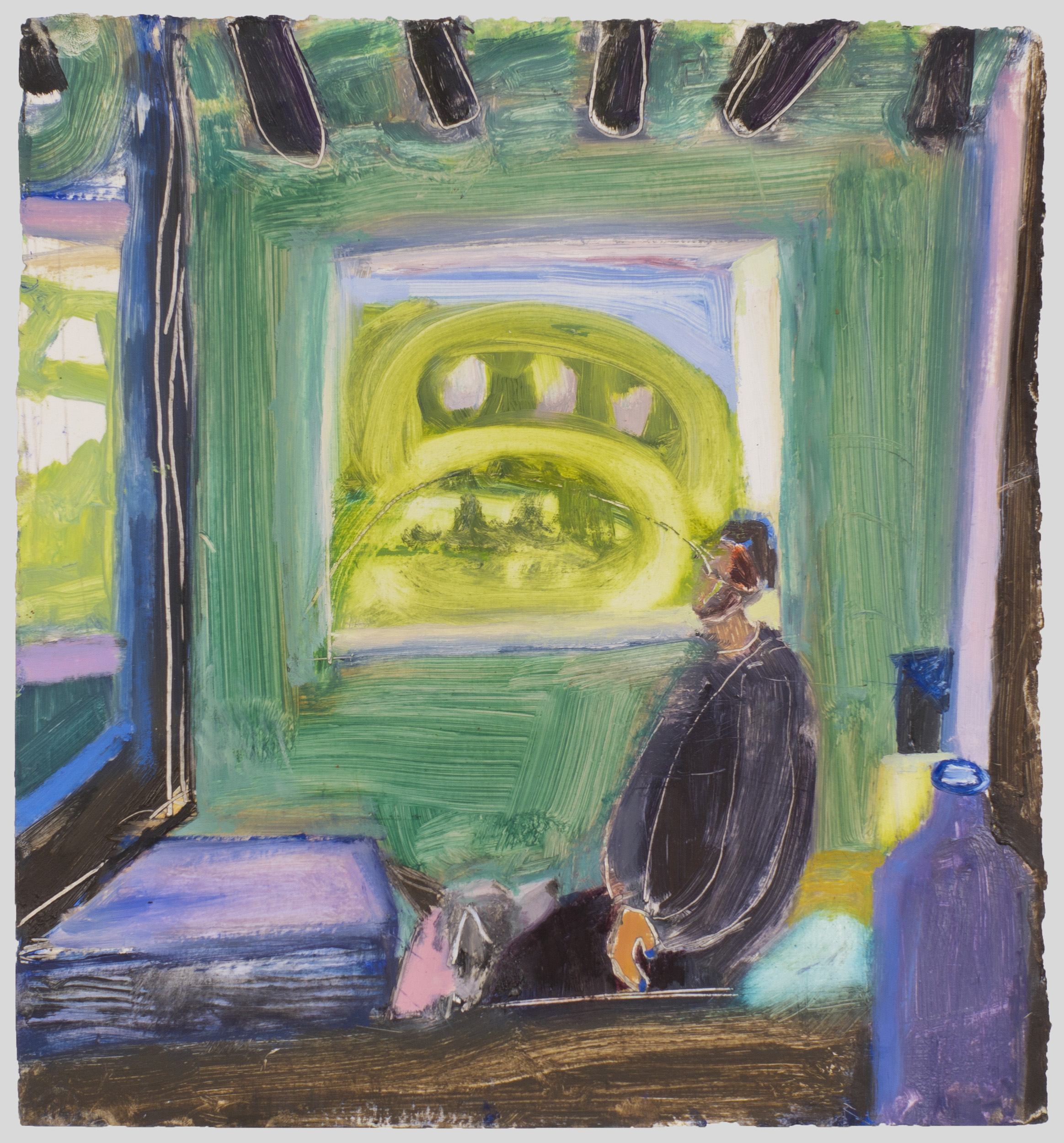
Elvira, 2019
Julie Karpodini
Oil on paper, 32.5 x 31 cm | 12.79 x 12.20 in
Lisa: Do you ever get stuck with a painting? And if so, how do you get unstuck?
Julie: I get stuck all the time! A good night’s sleep and a fresh eye is always good. Turning a painting upside down, or looking at it through a mirror is very helpful as it abstracts the elements again, so you can start to see in a way that relates to the painting as a whole and maybe not so much what you are stuck on. I have mirrors set up in my studio so that I am always backing away and looking at it through its reflection. If a painting holds together upside down, then I am pretty happy with it. When you work on it upside down you are forced to make relational changes in response to the painting itself as opposed to rational thought, or what you think the painting needs. Another great thing is to get rid of something that feels too important, too precious. If I am really stuck the only thing that works is a large change. Opening it up again in a big way. Sometimes I like something and work around it, but can’t get it right. In the end the thing I am working around needs to go. It is hard at times not to be precious but it is also the only way to get clarity, to get honesty. I cycle through all of these methods to try and solve the larger problems. I am also always drawing and painting from the painting. It’s a good way to see new possibilities and also to see the beauty of the shapes that are already there but maybe need to be brought forward, to clarify the whole. If none of this works, I put the painting away for a while, out of sight, and then after a few months try again. Another thing that can work is to leave it out, but work on another painting. Sometimes when I see it out of the corner of my eye while I work on something else, I have an aha moment. I recently have started with my work on paper to make any large colour and compositional changes on another piece of paper and then try it out. I can keep the work fresher that way especially with the Flashe paint because it loses a lot when it is overworked. If I can’t make the colour change I want directly on the paper, I will collage it in.
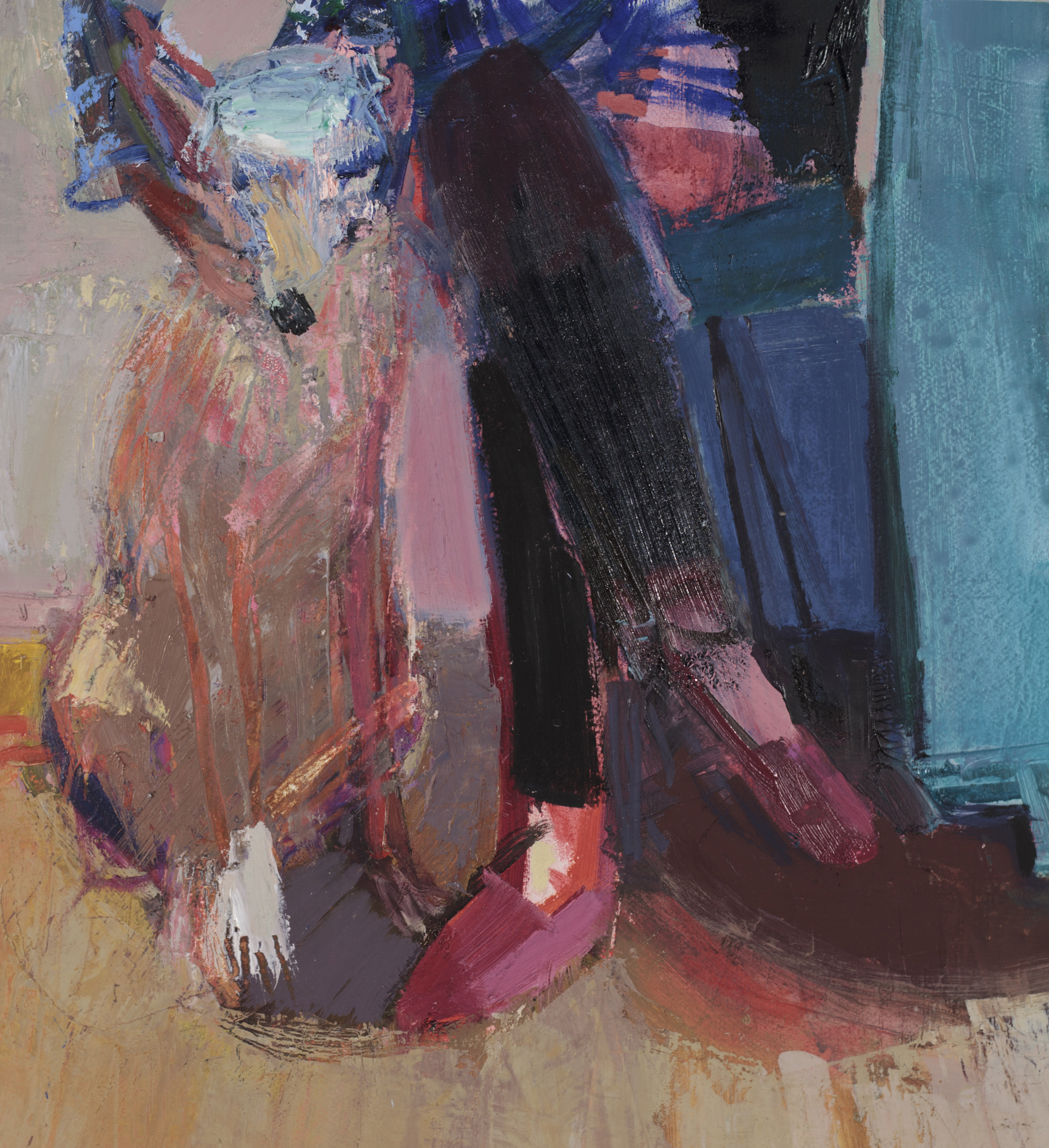
Elvira and Yayi, 2021
Julie Karpodini
Oil on canvas, 27.5 x 26 cm | 10.82 x 10.23 in
Lisa: Reflecting on the year so far, how has your creativity developed this year? And how do you envisage the development continuing into 2023?
Julie: This year I have really changed some important aspects of my work and I am happy with the direction that it’s headed. I feel like somehow new ground has been broken. 2023 will be an exciting year for me as I have a solo show at the end of the year, so that is a big incentive to stay focused when I am in my studio!
I have an upcoming solo show in 2023 at the Maya Gallery in Tel Aviv.

Barry and Michele, 2021
Julie Karpodini
Oil and Acrylic on canvas, 100 x 100 cm | 39.3 x 39.3 in
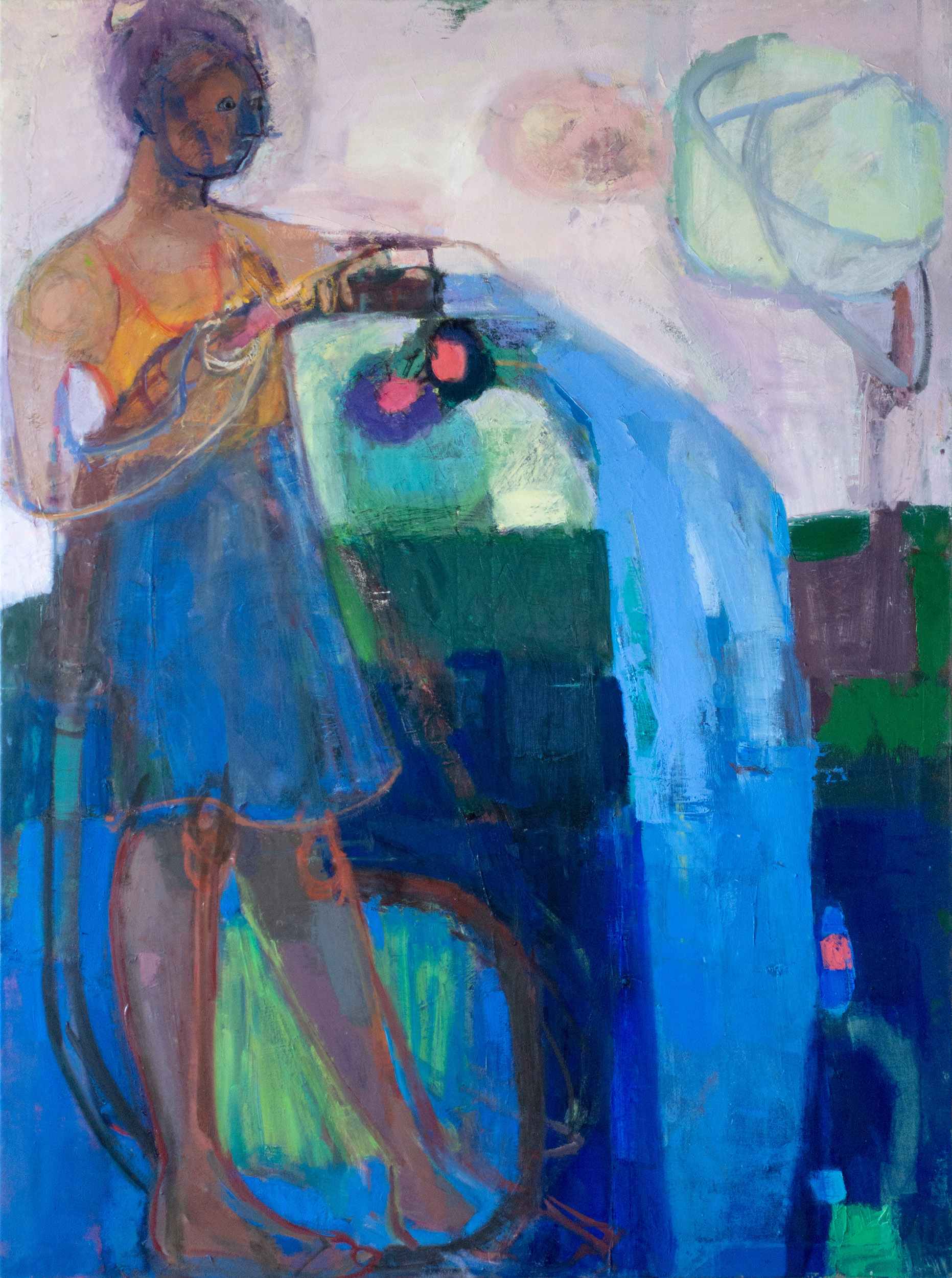
Watering, 2018
Julie Karpodini
Oil on canvas,130 x 97 cm | 51.18 x 38.18 in
Further Reading
Creating Oil Paintings That Stand the Test of Time
Everything You Need to Know About Oil Painting Paper
Oil Painting for Beginners: What You Need to Get Started
Size, Primer, Gesso and Ground Explained
Shop Oil Painting on jacksonsart.com
